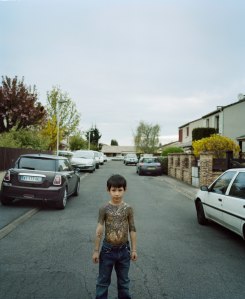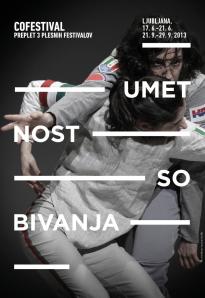Lil’dragon has been performed about a dozen times, in Vienna and on national and regional stages in France. What comes to my mind above all with this piece is the impact of working with children... the impact on stage (which is something we expected even before getting down to work) and the impact on the creative process.
In fact, there have been as many different creations as groups of children. We knew it and we were looking forward to it but experiencing it was something else. So that is what I would most like to tell you about today.
 Children, a living material
Children, a living material
Children are a living material for the stage: they bring reality to it. Each group was also a social material that gave a different colouring to the stage, which is something that greatly inspired us.
In Vienna, for example, the children were already aware of what dance involves. We had our fears because we didn’t want any formatting. One of the little girls had already adopted the ballet posture and she even came on tiptoes to the rehearsals. In this case, however – just as always – we quickly saw that children are children in their childish bodies. They hadn’t anchored other people’s gazes within themselves and we were quickly able to work on their interiority and their interiority’s expressivity, which is what we actually want to deal with. In fact, with these Viennese children, we were even surprised to see that this task was easier than usual on certain levels: they were more familiar with learning a choreography but they preserved this quality of spontaneous bodies that we wished to present.
With the children, however, there was no “ideal configuration”: each group had its own strength and we based our work on it. In Evry, for example, this strength was a more mixed, dynamic and maybe even raw culture: the children’s bodies were more mobile and their “copy” of the older people’s dance was more personal. On stage, the group of children, who were more detached from mimicry, revealed however a greater overall coherence, with individual precisions that it was not our job to define.
In short, the children have been a continuous source of inspiration. In one of the groups, the duet with Meah Savay was performed by a little Cambodian girl who had been adopted. For us, and perhaps for her, it could not be otherwise.
The teaching experience
In the parent-children teaching workshops that we held the teachers were a tie, a medium and a precious help. We answered all the questions – they were curious above all about the mata children’s tattoos: Why are tattoos forbidden? Why do they wear them? I found this to be an interesting approach to a different reality and to the conditions in which children live.
A real-time creation
We had a few misfortunes: one of our two dancers was injured just a couple of weeks before the debut performances and we had to arrange to cover her role with someone else. Then the robots used for the digital projections were delivered late and, on top of it all, we were affected in all respects by budget cuts in this complicated production. The preview in Vanves was one of the most difficult.
Crowdfunding experiments
The reduction of our budget led us to try out the crowdfunding system. While crowdfunding calls for a big effort (communication, reciprocations…), it allowed us to raise a little over 5,000 euros directly from the public.
The Meah Savay experience
Meah Savay, a one-time ballet star in Cambodia, hadn’t been on stage since 2008. It was her first contemporary creation. She didn’t speak much French and the presence of the children was like a resurgence of the time in her life when she ran the dance school of a refugee camp. Meah showed a maternal attitude. She also told us that some traditional dancers found her manners strange, that is to say, they found some of her gestures, like putting her mask on the ground, to be almost sacrilegious.
An evolution
This was for everyone, I think, an important experience, a time of exchange and discoveries, and also an experience of accepting difference. I often had the impression that the children understood what was happening better than anyone else. One of the children from Toulouse wrote to us after the production: “I saw two of my friends in judo class who made me think of Augustin and Morgan. I had a dream. I was going to go on a trip with the group and all of a sudden we were taken hostage by some people. We had to get away at all costs (...) Then we found ourselves in a little village with two people who taught us to expand our imagination by dancing and they were called Eric and Gaetan. Thanks for the good time I had at the CDC. Antoine”. In just this way, I hope we will all be long remembering this project as a highly positive experience.


